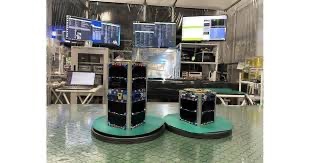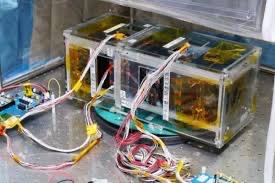

Nagoya Univ.: Orbit control without using fuel!
– Utilizing Air Molecular Resistance in Outer Space –
– Automatic adjustment of satellite attitude and position –
Nagoya University:
It is possible to control orbit and form formations in space without using engines or fuel.
MAGNARO, a microsatellite, was developed by Nagoya University and released to the press on the 26th.
small solid fuel rocket
Epsilon Unit 6
In October, we will conduct a demonstration experiment with Epsilon-6 from the Uchinoura Space Center.
Conventional small satellite:
Artificial satellites usually use engines to control their orbits.
However, small satellites have power, mass and space constraints.
Engineless satellites:
Once the engine is no longer needed, the empty space can be used to mount telescopes and other equipment.
Since it does not run out of fuel, it can be used for a long time.
Microsatellite MAGNARO specifications:
Microsatellite MAGNARO
It is 10 centimeters long, 10 centimeters wide, and 34 centimeters high, and weighs about 4.4 kilograms.
In the experiment, MAGNARO split into two in space.
Using the resistance with air molecules that exist slightly,
It automatically adjusts its attitude and position, forms a formation and circles the orbit.
– Sankei News
https://www.sankei.com/article/20220826-NZXEZU743ZOSDMTXBEDBNQU3UM/
Nagoya Univ. : Contrôlez l’orbite sans utiliser de carburant !
– Utilisation de la résistance moléculaire de l’air dans l’espace extra-atmosphérique –
– Ajustement automatique de l’attitude et de la position du satellite –
Université de Nagoya :
Il est possible de contrôler l’orbite et de former des formations dans l’espace sans utiliser de moteurs ni de carburant.
MAGNARO, un microsatellite, a été développé par l’Université de Nagoya et présenté à la presse le 26.
petite fusée à combustible solide
Unité Epsilon 6
En octobre, nous mènerons une expérience de démonstration avec Epsilon-6 depuis le Centre spatial d’Uchinoura.
Petit satellite conventionnel :
Les satellites artificiels utilisent généralement des moteurs pour contrôler leurs orbites.
Cependant, les petits satellites ont des contraintes de puissance, de masse et d’espace.
Satellites sans moteur :
Une fois que le moteur n’est plus nécessaire, l’espace vide peut être utilisé pour monter des télescopes et d’autres équipements.
Comme il ne manque pas de carburant, il peut être utilisé pendant longtemps.
Spécifications du microsatellite MAGNARO :
Microsatellite MAGNARO
Il mesure 10 centimètres de long, 10 centimètres de large et 34 centimètres de haut et pèse environ 4,4 kilogrammes.
Dans l’expérience, MAGNARO s’est scindé en deux dans l’espace.
En utilisant la résistance avec des molécules d’air qui existent légèrement,
Il ajuste automatiquement son attitude et sa position, forme une formation et fait le tour de l’orbite.
– Nouvelles du Sankei
Nagoya Univ.: Bahnsteuerung ohne Treibstoffverbrauch!
– Nutzung des molekularen Luftwiderstands im Weltraum –
– Automatische Anpassung der Satellitenlage und -position –
Universität Nagoya:
Es ist möglich, die Umlaufbahn zu kontrollieren und Formationen im Weltraum zu bilden, ohne Motoren oder Treibstoff zu verwenden.
MAGNARO, ein Mikrosatellit, wurde von der Universität Nagoya entwickelt und am 26. für die Presse freigegeben.
kleine Festbrennstoffrakete
Epsilon-Einheit 6
Im Oktober werden wir ein Demonstrationsexperiment mit Epsilon-6 vom Uchinoura Space Center durchführen.
Herkömmlicher Kleinsatellit:
Künstliche Satelliten verwenden normalerweise Motoren, um ihre Umlaufbahnen zu steuern.
Kleine Satelliten haben jedoch Leistungs-, Masse- und Platzbeschränkungen.
Motorlose Satelliten:
Sobald der Motor nicht mehr benötigt wird, kann der leere Raum verwendet werden, um Teleskope und andere Geräte zu montieren.
Da ihm der Kraftstoff nicht ausgeht, kann er lange verwendet werden.
Spezifikationen des Mikrosatelliten MAGNARO:
Mikrosatellit MAGNARO
Es ist 10 Zentimeter lang, 10 Zentimeter breit und 34 Zentimeter hoch und wiegt etwa 4,4 Kilogramm.
Im Experiment teilte sich MAGNARO im Weltraum in zwei Teile.
Unter Verwendung des Widerstands mit Luftmolekülen, die geringfügig vorhanden sind,
Es passt seine Lage und Position automatisch an, bildet eine Formation und umkreist die Umlaufbahn.
– Sankei-Nachrichten